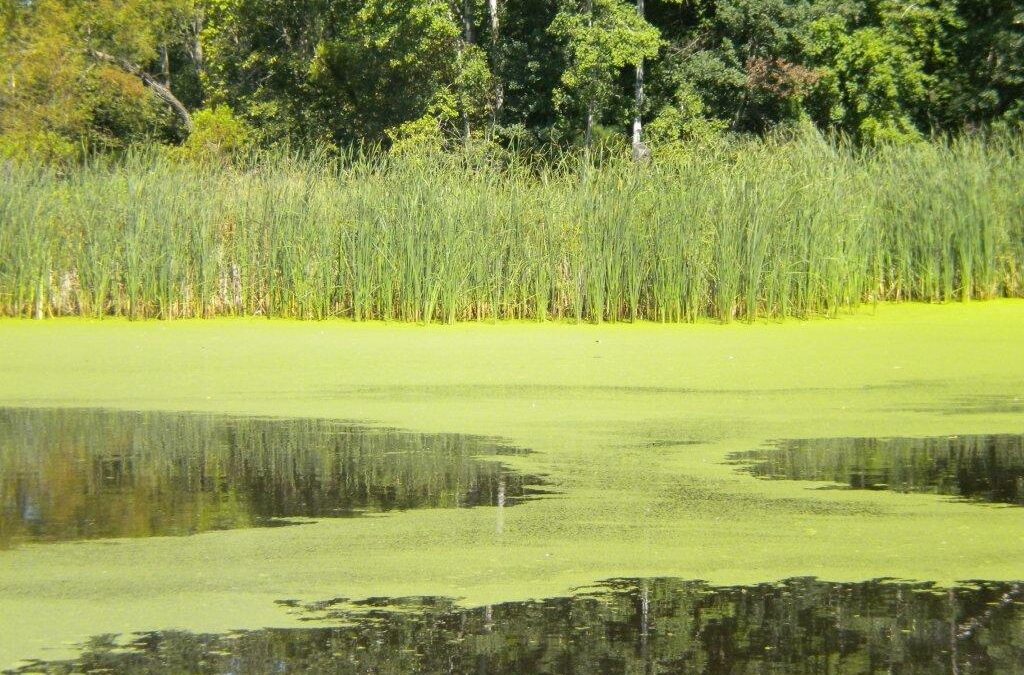Pond owners, ever wondered why your once-clear pond water turns murky or green? Multiple factors contribute to this phenomenon, making it challenging to restore the water to its original color. We at Healthy Ponds will unveil the frequent culprits behind cloudy ponds, helping you restore your aquatic haven to its pristine beauty.
For more tips and information on our all-natural pond water cleaners, don’t hesitate to reach out to our team!
1. Fluctuating pH Levels
Imbalanced pond pH, whether too high or low, influences bacteria’s efficiency in algae removal. Elevated pH (alkalinity) can hinder bacteria’s algae consumption and replication, promoting algae growth and hindering bacterial control. Just as temperature affects bacteria, specific parameters are essential for optimal performance. Use a testing kit to gauge your pond’s pH, ideally maintaining it between 7.5 to 8.5, for effective bacterial action.
2. Incorrect Pond Water Volume
Understanding your pond’s water volume is crucial for effective treatment. It’s often the primary reason for insufficient progress in water clarity. To determine your pond’s volume, use a measuring tape to gauge its width, length, and depth. Multiply these measurements, then by 1000, to find the water volume.
3. Grass Accumulation
Another factor impacting your pond’s clarity is grass. You could be maintaining your pond correctly, with functional filters and balanced chemistry, yet still have green water. So, why isn’t your pond clearing up?
In certain situations, when a pond is situated near grass or grass clippings find their way into the water during mowing, they can actually tint the water. The extent of this effect depends on the pond’s size and the amount of grass involved. If you suspect this is the issue, perform 20-30% water changes over a few weeks to eliminate the natural dye.
4. New Pond Plants
Nitrogen can enter a pond through newly acquired pond plants. Plants from garden centers and nurseries are often nourished with nitrogen fertilizers for their health, which eventually seeps into the pond, elevating nitrate levels.
Fortunately, a straightforward remedy exists. You don’t need to discard your pond plants. Just place newly purchased pond plants in a bucket of tap water for a week before introducing them to your pond. This process allows the nitrogen-rich fertilizer to leach out, ensuring the safe addition of the plants to your pond.
5. Activated UV Lights
A common query from customers pertains to whether it’s advisable to keep UV filters active in their ponds when using our treatments. UV Filters, also known as ‘clarifiers,’ emit intense ultraviolet light that targets single-celled algae, damaging their DNA and eradicating them. However, this same UV light can also exterminate beneficial pond bacteria vital for deterring organic waste and algae accumulation.
Many customers have employed our products successfully to clear ponds that were previously equipped with UV filters, indicating that beneficial bacteria might excel at maintaining pond clarity. Some even mention they never bothered reactivating their UV lights.
6. High Amounts of Nitrate
Nitrates serve as algae’s nourishment. When nitrate levels remain elevated without reduction, algae gain an inexhaustible food source, allowing them to proliferate more rapidly than bacteria can control. Algae thrive in ponds abundant in nitrogen. High nitrate levels offer algae an unrestricted food supply, enabling accelerated growth that may surpass the beneficial bacteria’s capacity to restrain it.
Much like pH assessments, you can gauge your pond’s nitrate levels using a testing kit. The recommended nitrate range for ponds typically falls between 20 and 60 ppm. If your pond exhibits elevated nitrate levels, this likely explains why your pond water remains unclear.
7. Using Water from a Well
Ponds refilled with well or borehole water near agricultural areas may encounter difficulties in achieving water clarity due to nitrate contamination. Nitrogen from agricultural fertilizers seeps into the soil, eventually infiltrating the watercourse and ponds. It’s crucial to ensure your pond’s pH and water conditions are balanced before commencing our all-natural treatments.
8. Utilizing the Incorrect Product
Occasionally, the reason your pond remains unclear may be as straightforward as using an incorrect product. Submerged algae might be confused with blanket weed, or green water might be mistaken for submerged algae.
Ensure accurate identification of your specific pond issue before purchasing a treatment. You can refer to our pond blogs for a deeper understanding of pond problems or reach out to us for technical guidance and support.
9. Not Allowing Enough Time
Sometimes, if your pond doesn’t clear up immediately after treatments, patience is key. The speed of improvement relies on several factors discussed in this post, but your pond’s size and condition are most critical.
With consistent treatments, results may show in as little as 2 weeks, depending on your pond’s condition. Typically, most ponds can expect improvement in 6 to 8 weeks. Remember, you’re using a natural, biological product, not chemicals, so results take time, especially for severely affected ponds.
Ask Healthy Ponds for More Tips and Information on Pond Water Cleaning and Maintenance!
Healthy Ponds is here to assist you in keeping your pond in the best condition possible. If you’ve used a product for an extended period and none of the mentioned factors apply, contact us for tailored advice and technical support.


